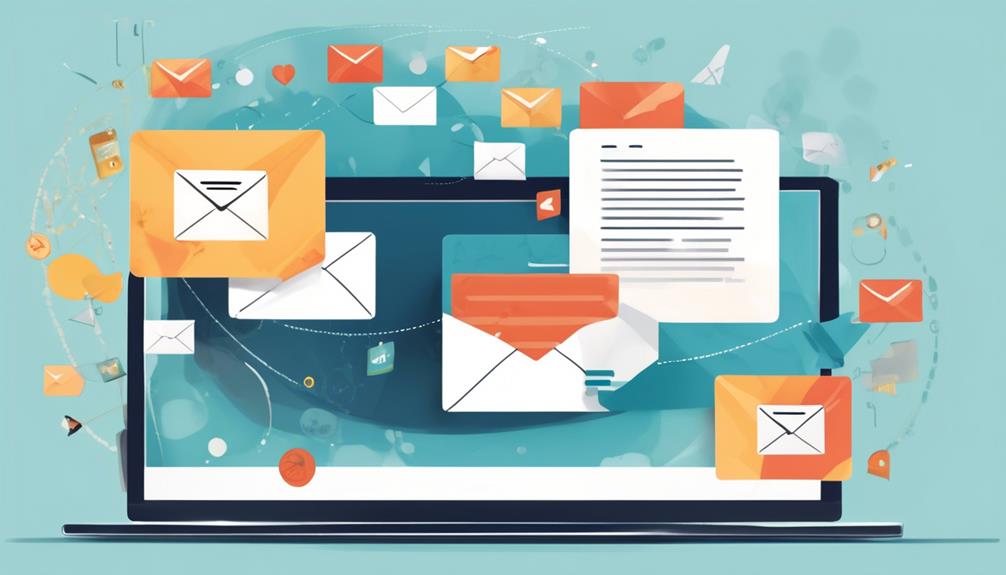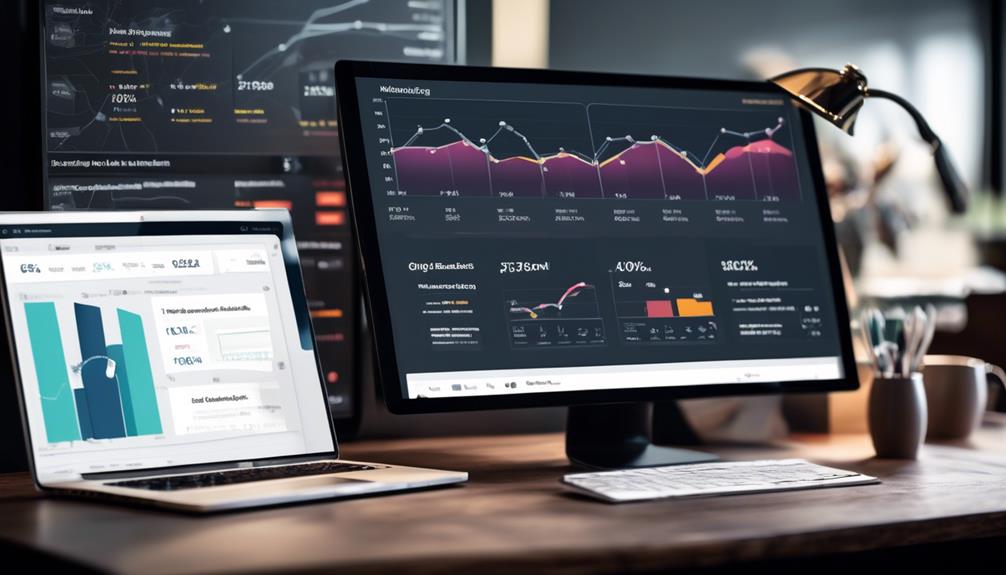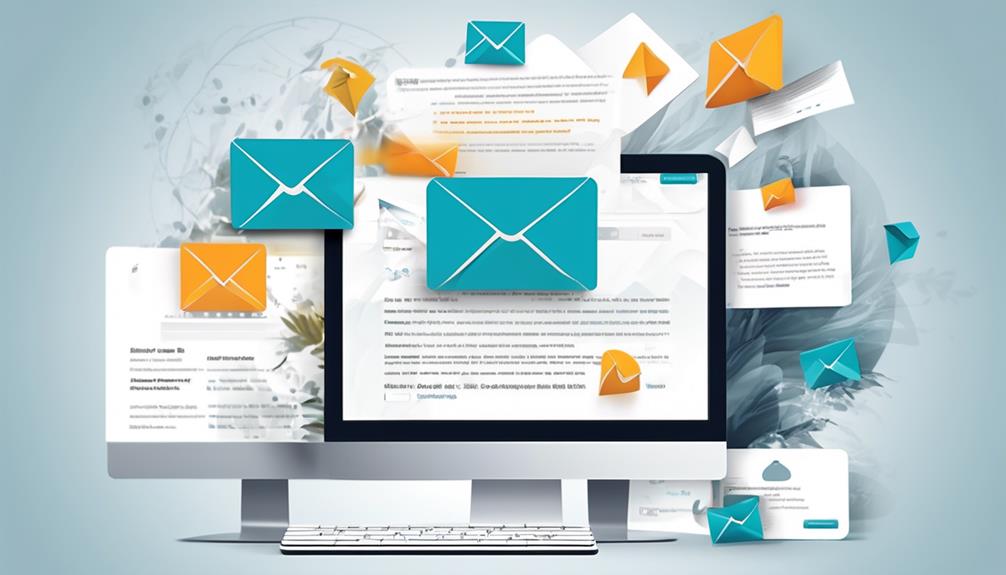Hey there, ever feel like you're trying to crack the code on how to level up your B2B relationships through email marketing?
Well, buckle up because we're about to dive into some seriously savvy strategies that can help you do just that.
From crafting killer content to targeting the right audience and analyzing those all-important metrics, we've got a whole bag of tricks to share with you.
So, grab a coffee and get ready to take your B2B email game to the next level.
Key Takeaways
- Email marketing is a powerful tool for fostering consistent communication and nurturing long-term B2B relationships.
- Personalizing email messages based on specific industries and buyer journeys enables personalized and effective communication.
- Providing valuable content, insights, and solutions helps build trust, establish expertise, and strengthen collaboration in the industry.
- Targeting the right B2B audience through segmentation, leveraging data, and experimenting with subject lines and content formats maximizes engagement and effectiveness.
The Role of Email Marketing in B2B Relationships
In building B2B relationships, email marketing plays a pivotal role by fostering consistent communication and nurturing long-term connections. It's like the digital cup of coffee you send to your business pals every morning. You know, that virtual nudge to remind them that you're there, ready to conquer the market together.
With email marketing, you can tailor your messages to suit specific industries, making your communication feel as personalized as a handwritten note. It's like having a chameleon for a marketing tool – it adapts to fit the environment it's in.
By delivering valuable content straight to your partners' inboxes, you're showing them that you're not just here to sell; you're here to share knowledge and insights. You become the friendly expert they can't wait to hear from, like that cool colleague who always has the best stories at the water cooler.
Understanding B2B Email Marketing
Curious about B2B email marketing? Let's dive in and unravel the secrets behind this powerful tool for nurturing business relationships. B2B email marketing is like a virtual handshake, but instead of just saying hello, you're offering valuable content, insights, and solutions to your fellow business pals. It's not about bombarding inboxes with sales pitches; it's about building rapport and trust.
Think of it as the digital version of chatting over coffee, except you're sharing industry news, success stories, and helpful tips.
One of the coolest things about B2B email marketing is its ability to personalize your interactions. You can tailor your messages based on where the recipient is in their buyer's journey, making the communication feel more like a thoughtful conversation rather than a mass-produced advertisement. Plus, with the magic of automation, you can schedule and send emails at the perfect time, ensuring that your message lands right when it's most relevant.
Understanding B2B email marketing is like mastering the art of the friendly follow-up. It's about staying top-of-mind without being pushy, offering value without expecting immediate returns, and ultimately, fostering long-lasting, mutually beneficial connections.
Crafting Compelling Email Content
Ready to start crafting compelling email content that will grab your B2B contacts' attention and keep them coming back for more?
The key to creating emails that resonate with your B2B audience is to be genuine and valuable. Think about what makes you open an email – it's probably not another sales pitch, right? Instead, it's likely something that offers real value, like a helpful tip, a solution to a problem, or a piece of insider knowledge.
So, when crafting your email content, focus on providing something that your B2B contacts can actually use. Maybe it's a case study showcasing how your product or service helped a similar company, or a guide that addresses a pain point they commonly face.
Also, don't forget to infuse your emails with a touch of personality. People want to connect with other people, not faceless corporations. So, inject some humor, share a personal anecdote, or simply write in a conversational tone.
Targeting the Right B2B Audience
Now that you've crafted compelling email content that adds genuine value and personality, it's time to ensure that it reaches the right B2B audience. Think of it like picking the perfect outfit for a first date. You want to impress, but you also want to be authentic and comfortable.
Start by defining your ideal B2B customer. What're their pain points, goals, and interests? Once you have this profile, use it to segment your email list. You wouldn't serve steak to a vegetarian, right? In the same way, you don't want to send technical jargon to a marketing team. Tailor your content to resonate with each segment.
You can also leverage data to target the right audience. Look at past engagement metrics to see which companies and individuals have shown interest in your emails. This is like knowing someone's favorite dessert before inviting them over for dinner. It shows that you care about their preferences.
Lastly, don't be afraid to experiment. Try different subject lines, content formats, and send times to see what resonates best with your audience. It's like test-driving a new car to see which features you love. Keep refining your approach, and soon you'll be hitting the bullseye with every email you send.
Personalization and Segmentation Strategies

Hey, you! Ready to take your B2B email marketing to the next level?
Personalization and segmentation are the secret sauces to make your emails stand out in a crowded inbox.
Get ready to learn how to tailor your content and campaigns for maximum impact!
Customized Content for Targeting
When creating customized content for targeting, it's essential to employ personalization and segmentation strategies that cater to the specific needs and preferences of your B2B audience. To keep things fresh and engaging, consider the following:
- Dynamic Content: Spice things up with content that adapts to the recipient's behavior and preferences.
- Behavioral Segmentation: Tailor your content based on how your B2B audience interacts with your emails and website.
- Personalized Recommendations: Offer personalized product or service recommendations based on the recipient's past purchases or browsing history.
- Localized Messaging: Speak your audience's language by customizing content based on their location or regional preferences.
Tailored Email Campaigns
After creating customized content for targeting, you can take your email marketing to the next level by implementing tailored email campaigns that utilize personalization and segmentation strategies to effectively engage your B2B audience.
Personalization is like adding sprinkles to your ice cream – it makes it more delightful. By using your recipient's name, company, or industry in the email subject line and content, you're showing that you see them as more than just another email address in your list.
Segmenting your audience is like organizing a party where everyone gets to enjoy their favorite activities. Segmenting your email list based on the recipient's behavior, preferences, or purchase history ensures that you're sending the right message to the right people at the right time.
It's like giving each guest at your party a personalized itinerary, making sure everyone has a blast.
Leveraging Email Automation for B2B Engagement
Leverage email automation to streamline your B2B engagement and enhance your communication with potential clients and partners. With the right automation tools, you can revolutionize your approach to B2B communication. Here's how:
- Personalized Nurturing: Use automation to send targeted content that speaks directly to the pain points and needs of your B2B contacts. It's like having a personalized conversation at scale.
- Behavior-Based Triggers: Set up triggers based on the actions of your recipients. Whether they open an email, visit your website, or download a resource, you can automatically follow up with relevant content.
- Lead Scoring and Segmentation: Implement automation to score your leads based on their engagement and segment them accordingly. This ensures that each lead receives content that aligns with their position in the buying cycle.
- Automated Follow-Ups: Say goodbye to manual follow-ups. With automation, you can schedule timely and personalized follow-up emails, ensuring that no opportunity slips through the cracks.
Analyzing Email Metrics for B2B Success

Hey there, it's time to put on your detective hat and analyze those email metrics!
Open rates and click-through rates may sound like numbers, but they hold the key to understanding how your B2B emails are performing.
Open Rate Analysis
When analyzing email open rates for B2B success, it's crucial to understand the factors that impact recipient engagement. Here are some key things to consider:
- Catchy Subject Lines: Think of them as the opening act to your email – make them catchy and intriguing.
- Timing is Everything: Sending an email at 3 AM mightn't be the best idea; consider the recipient's time zone and daily schedule.
- Personalization: Make your emails feel like they were crafted just for the recipient – nobody wants to feel like they're just another name on a list.
- A/B Testing: Don't be afraid to experiment with different approaches to see what works best for your audience.
Click-Through Rate Evaluation
To measure the effectiveness of your B2B email campaigns, evaluating the click-through rate is essential for understanding how recipients are engaging with your content.
The click-through rate (CTR) tells you how many people clicked on a link in your email, showing their interest in your offering. It's like the digital version of a nod or a thumbs-up! A high CTR indicates that your email content is compelling and relevant to your audience.
On the other hand, a low CTR might mean that your content needs some tweaking. By analyzing the CTR, you can see which emails are resonating with your recipients and which ones are falling flat.
This insight allows you to refine your email strategy and create more engaging content for better B2B relationships.
Building Trust and Credibility via Email
Establishing trust and credibility through email is essential for nurturing B2B relationships and fostering long-term partnerships. To build a strong foundation of trust and credibility via email, consider the following:
- Authentic Communication: Be genuine and transparent in your emails. Avoid using overly formal language or industry jargon that can create a barrier between you and your recipients.
- Consistent Branding: Ensure that your emails reflect your brand identity consistently. Consistency in design, tone, and messaging helps to establish familiarity and trust with your audience.
- Valuable Content: Deliver content that's relevant, valuable, and tailored to your recipients' needs. Providing insightful information demonstrates your expertise and builds credibility.
- Personalization: Use personalization techniques to make your emails feel more human and less like automated messages. Address your recipients by name and provide content that's tailored to their specific interests.
Nurturing B2B Leads With Email Campaigns

Now that you've laid the groundwork for trust and credibility in your B2B email communications, it's time to explore how to effectively nurture those leads through engaging email campaigns.
Think of your email campaigns as the gentle nudge that keeps your B2B leads moving through the sales funnel. Start by personalizing your emails based on the interests and behaviors of your leads. Tailoring your content shows that you understand their needs, making them more likely to engage with your emails.
Keep your content fresh and valuable. No one likes stale bread, and the same goes for emails. Share industry insights, success stories, and useful tips. Make sure your emails are like a good conversation – engaging and two-sided. Encourage feedback and questions, and be responsive to their inquiries.
Another essential aspect is timing. Don't bombard your leads with emails, but also don't disappear for weeks on end. Finding the right balance will keep your brand top-of-mind without overwhelming them.
Lastly, don't forget to track your results. Use analytics to see what's working and what's not, and then adjust your approach accordingly. Nurturing B2B leads through email campaigns is all about building and maintaining valuable relationships.
Optimizing B2B Email Marketing for Conversions
Hey there, ready to take your B2B email game to the next level?
We're about to dish out some juicy tips on email design, audience targeting, and crafting killer calls-to-action.
Get ready to optimize your emails for maximum conversions and watch those leads turn into loyal customers!
Email Design Best Practices
When designing your B2B marketing emails, keep in mind that the goal is to create a visually appealing and engaging layout that drives conversions.
To achieve this, consider the following best practices:
- Use eye-catching graphics and images to grab attention
- Keep the content concise and focused on the main message
- Incorporate a clear call-to-action that prompts immediate response
- Ensure mobile responsiveness for easy access on all devices.
Targeted Audience Segmentation
To optimize your B2B email marketing for conversions, targeted audience segmentation is essential for delivering personalized, relevant content to your recipients.
Think of it like this: you wouldn't offer a steak dinner to a vegetarian, right? The same goes for your email marketing.
By segmenting your audience based on their interests, behaviors, and needs, you can send them content that speaks directly to them. It's like having a one-on-one conversation with each recipient, but without the awkwardness.
Plus, when your audience feels like you understand them, they're more likely to engage with your emails and, ultimately, convert.
Call-To-Action Optimization
Make your call-to-action (CTA) stand out like a disco ball in a dark room – it needs to grab attention and compel action!
- Keep it clear and concise: No one has time for a CTA that beats around the bush.
- Use compelling language: Make them an offer they can't refuse.
- Create a sense of urgency: Let them know that they can't afford to miss out.
- Test, test, test: Don't be afraid to experiment with different CTAs to see what resonates best with your audience.
Frequently Asked Questions
How Can B2B Companies Effectively Handle Email Deliverability and Avoid Spam Filters?
You'll ace email deliverability by crafting engaging, relevant content, using a reliable ESP, and maintaining a clean email list. Avoid spam filters by avoiding excessive salesy language, implementing double opt-ins, and ensuring proper authentication.
What Are Some Best Practices for Integrating Email Marketing With Other B2B Marketing Strategies, Such as Social Media or Content Marketing?
You want to integrate email marketing with other B2B strategies like social media or content marketing. It's crucial to coordinate your efforts, maintain consistent messaging across platforms, and leverage each channel's strengths for maximum impact.
Are There Any Specific Legal Considerations or Regulations That B2B Companies Need to Be Aware of When Conducting Email Marketing Campaigns?
When doing B2B email marketing, be aware of legal stuff! Regulations like CAN-SPAM Act require permission to email, clear opt-out options, and truthful header info. Keep it legit to avoid trouble.
How Can B2B Companies Use Email Marketing to Re-Engage With Dormant or Inactive Leads?
Hey there! Re-engaging dormant leads is like waking sleeping giants. Send personalized, value-packed emails with irresistible offers, create a sense of urgency, and leverage storytelling to reignite their interest. You've got this!
What Are Some Effective Strategies for Measuring the ROI of B2B Email Marketing Efforts and Attributing Success to Specific Campaigns or Initiatives?
To measure the ROI of your B2B email marketing efforts, start by setting clear goals and tracking key metrics like open rates, click-through rates, and conversion rates. Use tools like Google Analytics to attribute success to specific campaigns or initiatives.